 |
  Home | Contact | Site Map |

| Top Destinations |
|
You are here Home » Top Destinations » Srilanka
Honeymoon in Srilanka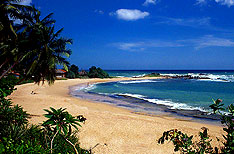 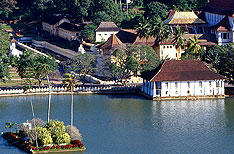 About Srilanka The island has been known by a variety of names, a list which is as varied as its historical influences. More than 2000 years ago the famous Indian epic "Ramayana" told of misdeeds of the wicked king of Lanka. The Dravids called the isle Ilankai; to the old Greeks and the Romans it was known as Taprobane; the Arabic merchants called it Serendib; the Portuguese Ceiloa; the Dutch changed the name into Ceylan, and the British to Ceylon. The Republic of Sri Lanka was born in 1972, the prefix "Sri" is Sanskrit in origin and means resplendent. From time immemorial the island has been subjected to many different influences, both occidental and oriental. Consequently this small island state contains an exotic mixture of languages, cultures and religions. The few thousand Veddhas who live in remote jungle areas are the descendants of the original inhabitants. The majority of the population are descendants of the Aryan tribes that came from North India over 2'000 years ago. Subsequent Dravidian invasions and Arab migrations have created a wonderful cosmopolitan society. BEACHES IN SRILANKANegomboA characteristic fishing town north of Colombo, it is a mere 6 km from the international airport. Set amidst lush groves of coconut palms, it breathes the spirit of the sea. Negombo is a gourmet?s paradise with sea food in plenty. Mount LaviniaMount Lavinia is an ideal place to relax and enjoy the sea. The beach is crowded on Sundays and public holidays with large crowds gathered to participate in many beach sports activities such as swimming, surfing etc. KalutaraAn important spice-trading centre controlled at various times by the Portuguese, Dutch and British. Today it has a reputation for fine basket ware (visit basket hall) and also for the best mangosteens on the island. Immediately south of the Kalu Ganga Bridge on the main road is the Gangatil Vihara, which has a hollow dagoba (Buddhist shrine) with an interesting painted terior. BeruwelaSouth of Colombo, Beruwela marks the beginning of a 130 km-stretch of beaches, where resort development has made immense strides in recent years. Good bathing in the bay all year round. BentotaBentota Resort complex is a romantic rendezvous of river and sea with several hotels, railway station, post office, shopping arcade, cafeteria and an open - air theatre showing folk and mask dancing with clusters of palms overlooking everything. HikkaduwaThe first area to be developed for Tourism, this is still one of the most popular of our beach resorts. Hikkaduwa is famous for its coral and sub tropical fish. The reef, which runs parallel to the shore and is only a few meters below the water, can be investigated with snorkel and flippers, or in a glass-bottomed boat. GalleSouth of Colombo, Galle is the most important southern town. It has an old world charm. Believed to be the ?Tarshish of the Bible?, its natural harbour was a famous fort in days gone by. Galle is famous for its Dutch fort, lace making, ebony carving and gem polishing. KoggalaKoggala beach is about 12 kms south of Galle. Stilt -Fisherman are a familiar sight here. Arugam BayArugam Bay is a fishing village 3km south of the small town of Pottuvil at the remote southern end of the east coast. It probably has the best surf in Sri Lanka, which forms near a low promontory a little further south, and because of this it has developed into a hang-out for low-budget travelers. NelaveliNilaveli is a prime beach resort in the East Coast. It is ideally suited for sun bathing, sea bathing and diving. A few metres off shore is a small rocky island good for snorkelling. Nilaveli was the venue for the 1985 International Fun Board Championships. WATERFALLS IN SRILANKABambarakande Falls, Diyaluma Falls, Kirindi Oya Falls, Olu Falls, St. Claire Falls, Bopath Falls, Laxapana Falls, Aberdeen Falls, Devon Falls, Rawana Falls, Elgin Falls, Bridal Falls, Ramboda Falls, Nawarathna Falls, Mapanana Falls. SOCIETY AND PEOPLEIt is customary to be offered tea when visiting and it is considered impolite to refuse. Punctuality is appreciated. A small token of appreciation, such as a souvenir from home or company, is always welcomed. Informal, Western dress is suitable. Visitors should be decently clothed when visiting any place of worship. Beachwear is not suitable for temples and shrines, and shoes and hats must be removed. Jackets and ties are not required by men in the evenings except for formal functions when lightweight suits should be worn. Sri lanka is a land of religious freedom and tolerance. Where-ever you travel in our island you will come across a Buddhist temple or dagoba, a Hindu Kovil, a Christian Church or a Mosque, each distinguish able by its own distinctive style of architecture. CULTURECulture Sri Lanka's classical architecture, sculpture and painting is predominantly Buddhist. Stupas sprinkle the countryside, and there are several extravagantly large Buddhas sculptures, notably at Aukana and Buduruvagala. Anuradhapura and Polonnaruwa have the most impressive archaeological legacy, but Kandy is the most thriving cultural centre today. Colonial remnants includes Dutch forts, canal and churches and British residences, clubs and court-houses. Galle is the finest colonial city on the island. BOTANICAL GARDENSA visit to the Royal Botanical Garden Paradeniya near Kandy, Hakgala Gardens near Nuwara Eliya and Botanical Gardens Gampaha will pay rich dividends. To the botanist, this is indeed a land of plenty. The diversified climate allows for the growth of tropical as well as sub-tropical trees. The luxuriant undergrowth and tall majestic trees of the wet-zone tropical forest contrast with the arid scrub land and talipot palms of the dry north. AYURVEDAAyurveda is nature?s way of caring and curing. The preparation of ayurvedic medications is usually a long process with ingredients being ground in pestle for a prescribed period of time. Juices and extracts of plants are simmered until they reduce to a fraction of their original volume. Besides decoctions, vines, pills and powders for internal use, ayurveda also uses poultices, pastes, ointments and oils for external application. ECOTOURISMEcotourism is based on the principles of responsible travel to natural and cultural areas, which conserves the environment, and sustains the well being of the local people. Ecotourism ranges from a casual walk through undisturbed forests to exploration and study of unique natural and cultural features in remote areas. Bio-diversity and rich cultural heritage are the important attributes of an ecotourism destination - both of which Sri Lanka is abundantly blessed with. MUSEUMSNational Museum,Colombo (Closed on Fridays), National Museum Of Natural History (Closed on Fridays), The Dutch Period Museum (Closed on Fridays), Kandy National Museum (Closed on Fridays & Saturdays), Ratnapura Museum (Closed on Thursdays & Fridays), Anuradhapura Folk Museum (Closed on Thursdays & Fridays), Galle National Museum (Closed on Sundays & Mondays), The National Maritime Museum, Galle (Closed on Fridays & Saturdays), Bandaranaike Museum, Jayawardane Cultural Centre, Maligawa Museum, Monument To Rajah (Former Maligawa Tusker), Koggala Folk Musuem, Archaeological Museum FOOD & DRINKStandard foods are spicy and it is advised to approach curries with caution. There are many vegetables, fruits, meats and seafoods. Continental, Chinese, Indian and Japanese menus are available in Colombo. A speciality is basic curry, made with coconut, sliced onion, green chilli, aromatic spices such as cloves, nutmeg, cinnamon and saffron and aromatic leaves.Hoppers are a cross between a muffin and a crumpet with a wafer-crisp edge, served with a fresh egg soft-cooked on top.Stringhoppers are steamed circlets of rice flour, a little more delicate than noodles or spaghetti. Jaggery is a fudge made from the crystallised sap of the kitul palm. The durianfruit is considered a real delicacy. SHOPPINGSpecial purchases include handicrafts and curios of silver, brass, bone, ceramics, wood d terracotta and also cane baskets, straw hats, reed mats and tea. Some of the masks, which are used in dance-dramas, in processions and on festival days, can be bought by tourists. Versions produced for the tourist market are often of a high standard. Sri Lanka is also rich in gems, especially cats eyes, rubies and other precious and semiprecious stones. Fabrics include batiks, cottons, rayons, silks and fine lace. Shopping hours: 0900-1730 Monday to Friday and 0900-1300 Saturday. ENTERTAINMENTNightlifeSome Colombo hotels have night clubs with music for dancing. There are also cinemas showing English films, ballets, concerts and theatre productions, mainly in Colombo. General Information of Srilanka LOCATIONAn island off the south-eastern cost shores of India, 880 km north of the equator, in the Indian Ocean. How to Reach By AirSri Lanka's national airline is Sri Lankan Airlines. Airport: 'Bandaranaike International Airport' is located - 32km (20 miles) from Colombo city. There are full duty-free facilities at the airport, as well as a restaurant & snack bar, bank, post office and car hire. Bus no. 240 goes to the city every 30 minutes between 0600-2100. It returns from Pettah bus station, Olcott Mawatha Street. Bus no. 187 goes to the city hourly 0600-2100. It returns from Fort bus station, Olcott Mawatha Street. Central Bus Station Pettah-tel.328081. Taxis to the city are available. There is a train to Maradana station (one mile from the Colombo city centre) at 0756, 0830, 1632 and 1720 (travel time : 1 hour 25 minutes). Return is from Fort railway station, Olcott Mawatha Street at 0510, 0526, 1340 and 1520. Embarkation tax : SLRs1000 is levied on all international departures. Transit passengers and children under two years are exempted. By SeaInternational ports include Colombo, Talaimannar, Trincomalee and Galle. Passenger services to Sri Lanka are operated by Flagship Cruises, Holland America, Nauru Line, Norwegian American, P&O, Royal Viking, CIT and Cunard. Cargo/passenger lines running services to Sri Lanka include Bank, Hauraise, Lloyd, Triestine and Swedish American. CLIMATELow Lands ? tropical, average 27C Central Hills ? cooler, with temperatures dropping to 14C. The south-west monsoon brings rain to the western, southern and central regions from May to July, while the north-eastern monsoon occurs in the north and east in December and January. Sri Lanka has a good climate for holiday-makers throughout the year. Places In SRILANKA Columbo
Negombo Negombo is the major beach resort on the coast north of Colombo. Here, in an old world atmosphere of 17th Century churches and forts; dozens and dozens of hotels, guest houses restaurants and bars have sprung up along the beach. Beside luxury hotels are small, very simple guests houses. What is left from the former fishing village, you can explore at the Negombo lagoon with its many outrigger canoes. Negombo is situated 40 km north of Colombo, close to the international airport. Long, palm-fringed, wide, sandy beaches are inviting for long walks and especially for sea bathing. With its many shops, restaurant and bars the centre of Negombo offers to the visitor many distractions. It is worthwhile to go on a boat trip to the lagoon or one of the old canals dating back to the Dutch colonisation. Kandy Kandy was been founded at the end of the 15th Century by a nobleman of the Singhalese court. There exist numerous legends about the foundation of the city, but there is also much evidence that the area was populated long before this foundation. Kandy is and has always been the centre of Singhalese nationalism. As defiant fortress in the mountains she successfully resisted the Portuguese and the Dutch, and it took the English two decades to conquer Kandy, capturing the last Singhalese king and sending him to India into exile where he later died. All Ceylon was then British colony and Kandy lost its role as capital but became due to its situation on 500 m above sea level a popular resort town of the new rulers. Later Kandy was the centre of the coffee industry and after a fungus infection destroyed almost all coffee plantations, a centre of the tea industry. Polonnaruwa
Sigiriya Kasyapa son of king Dhatusena (459 - 477 AC.) had his father arrested and walled alive within his tomb. His brother Moggallana, who was the legitimate successor to the throne, was sent into exile abroad, and Kasyapa was named king. As he had the power, he was in constant fear of his life. For this reason, he left the capital city of Anuradhapura and went into the wilderness where he built on top of a huge monolith which, rises 200 m from the jungle into the sky, his palace. Around this rock he constructed impressive fortifications. From Sigiriya he ruled the kingdom for 18 years (479 - 497 AC) until such time his brother Moggallana returned from India with an army. Beaten in battle he committed suicide in his rock fortress. Nuwara Eliya Nuwara Eliya is situated in the central mountains - 2'000 m above sea level. It is Sri Lanka's premier hill resort. Splendid scenery and fine bracing mountain climate. Temperature average 10? C. Nuwara Eliya is decidedly English in someway (houses , gardens and places names) and was actually planned to be an English village by a pioneering Englishman, Sir Samuel Baker in the mid 19th Century. Heart of Sri Lanka's tea country, Nuwara Eliya teas are some of the country's best. Anuradhapura
|
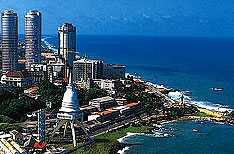 Columbo is the commercial capital of Sri Lanka! Over 2 million people live in this vibrant city. While sometimes busy and hectic, visitors to this city can witness many of Colombo's treasures. The Fort area is the business center of the country and is home to the World Trade Center, as well as other modern buildings. A stroll along Galle Face Green allows a fantastic view of the Indian Ocean, and if timed right, a spectacular sunset. Cinammon Gardens is home to many of the city's most luxurious homes. The Pettah area is a bazaar where one can watch people bargain for just about anything.
Columbo is the commercial capital of Sri Lanka! Over 2 million people live in this vibrant city. While sometimes busy and hectic, visitors to this city can witness many of Colombo's treasures. The Fort area is the business center of the country and is home to the World Trade Center, as well as other modern buildings. A stroll along Galle Face Green allows a fantastic view of the Indian Ocean, and if timed right, a spectacular sunset. Cinammon Gardens is home to many of the city's most luxurious homes. The Pettah area is a bazaar where one can watch people bargain for just about anything.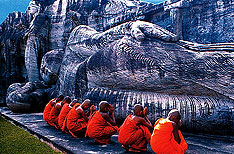 Polonnaruwa is second of importance as royal city to Anuradhapura. In the 11th Century the capital was moved from Anuradhapura to Polonnaruwa, as it was hoped that this new residence in such a difficult accessible area would be better protected from the notorious raids from the Indian Sub-Continent As a result Polonnaruwa became a splendid residence and capital. During the reigns of the kings Parakrama Bahu the Great (1153 - 1186) and his successor Nissanka Malla 1187 - 1196 the Singhalese kingdom reached its last golden age, of which the splendour of its buildings and palaces the impressive irrigation system with artificial lakes, tanks and channels give clear evidence.
Polonnaruwa is second of importance as royal city to Anuradhapura. In the 11th Century the capital was moved from Anuradhapura to Polonnaruwa, as it was hoped that this new residence in such a difficult accessible area would be better protected from the notorious raids from the Indian Sub-Continent As a result Polonnaruwa became a splendid residence and capital. During the reigns of the kings Parakrama Bahu the Great (1153 - 1186) and his successor Nissanka Malla 1187 - 1196 the Singhalese kingdom reached its last golden age, of which the splendour of its buildings and palaces the impressive irrigation system with artificial lakes, tanks and channels give clear evidence.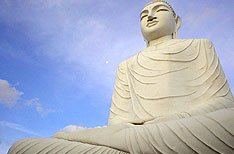 From written records, Anuradhapura was made the royal capital by the king Panduk-Anhaya in 380 BC. It remained residence and royal capital for 119 successive Singhalese kings till the year 1000 AC when it was abandoned and the capital was moved to Polonnaruwa. In the 3rd Century BC the missionary Mahinda son of the North-Indian emperor Asoka brought the teachings of Buddha to Anuradhapura, which has to this day influenced Buddhism in Sri Lanka in the form of the Theravada school. After the conversion of the kingdom to Buddhism an extraordinary age of cultural ascendancy and common weal started.
From written records, Anuradhapura was made the royal capital by the king Panduk-Anhaya in 380 BC. It remained residence and royal capital for 119 successive Singhalese kings till the year 1000 AC when it was abandoned and the capital was moved to Polonnaruwa. In the 3rd Century BC the missionary Mahinda son of the North-Indian emperor Asoka brought the teachings of Buddha to Anuradhapura, which has to this day influenced Buddhism in Sri Lanka in the form of the Theravada school. After the conversion of the kingdom to Buddhism an extraordinary age of cultural ascendancy and common weal started.